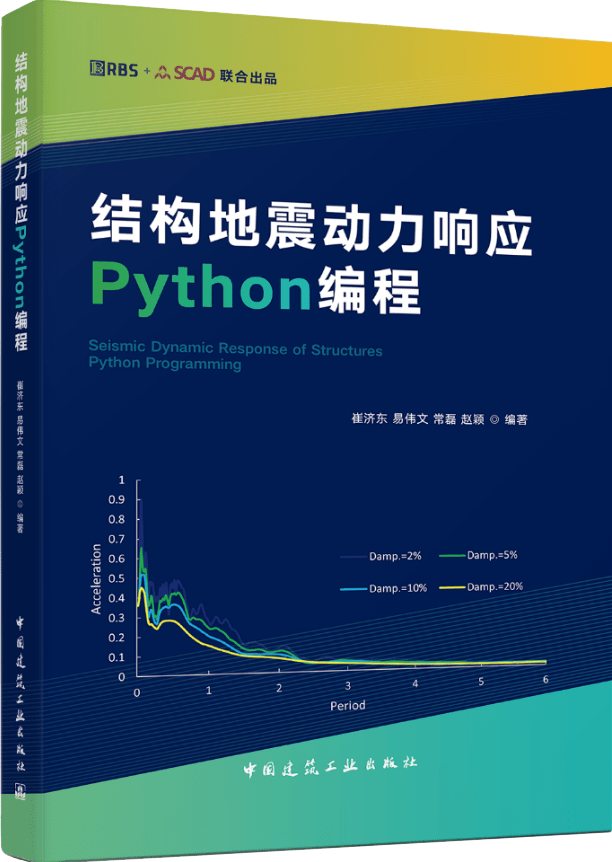实干、实践、积累、思考、创新。
今天是20181231,2018年的最后一天,希望新的一年会更好。
接着博文《[力学][有限元][FEM]Basics of Buckling Analysis [曲屈分析基础]》继续介绍框架单元(Frame Element)用于屈曲分析的方法。该部分内容也是 书本 《有限单元法:编程与软件应用》屈曲分析章节的部分内容节选。
11.4 屈曲分析2:2D框架
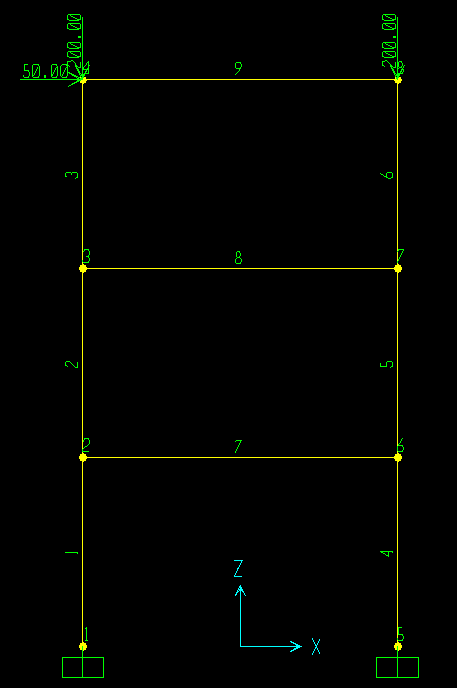
图 11‑7 结构模型示意
图 11‑7是本章的算例结构,是一榀平面框架结构,结构几何信息、构件属性和约束信息与第二章中静力分析时相同,荷载样式为:节点4处受到+x方向50kN的集中力和-z方向的100kN集中力作用,节点8受到-z方向的100kN集中力作用。本章将基于欧拉梁单元对该结构进行图中荷载样式下的屈曲分析,并将基于MATLAB编程计算的结果与SAP2000、midas Gen分析结果进行对比。
以下直接给出欧拉梁单元的几何刚度矩阵
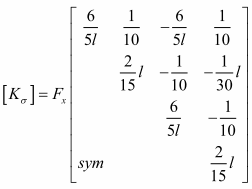 (11.4‑1)
(11.4‑1)
其中Fx为单元轴力。
11.4.1 MATLAB代码与注释
屈曲分析的Matlab代码与前面章节中静力分析的Matlab代码略有不同,这里给出进行屈曲分析所需的主要代码。
% Frame 2D Buckling Analysis
% Author : JiDong Cui(崔济东),Xuelong Shen(沈雪龙)
% Website : www.jdcui.com
% 20170609
……
此前代码与静力分析代码相同,不再赘述。
% Loading
force(10)=50;
force(11)=-200;
force(23)=-200;
……
根据图 11‑2,为相应的自由度施加荷载,作为参考荷载,用于后续求解单元的几何刚度矩阵。
% Solute balance function
disp('Displacement')
displacement(activeDof) = stiffness( activeDof , activeDof)\force(activeDof)
% Element force
disp('Force')
AxialForce=zeros(numEle,1);
for i=1:numEle
noindex = EleNode(i,:);
deltax = xx( noindex(2)) - xx( noindex(1));
deltay = yy( noindex(2)) - yy( noindex(1));
L = sqrt( deltax*deltax + deltay*deltay );
C = deltax / L;
S = deltay / L;
T = [ C S 0 0 0 0;
-S C 0 0 0 0;
0 0 1 0 0 0;
0 0 0 C S 0;
0 0 0 -S C 0;
0 0 0 0 0 1
];
E = EList(EleSect(i));
A = AList(EleSect(i));
I = IList(EleSect(i));
EAL = E*A/L;
EIL1 = E*I/L;
EIL2 = 6.0*E*I/(L*L);
EIL3 = 12.0*E*I/(L*L*L);
% Element stiffness matrix
eleK = [ EAL 0 0 -EAL 0 0;
0 EIL3 EIL2 0 -EIL3 EIL2;
0 EIL2 4*EIL1 0 -EIL2 2*EIL1;
-EAL 0 0 EAL 0 0;
0 -EIL3 -EIL2 0 EIL3 -EIL2;
0 EIL2 2*EIL1 0 -EIL2 4*EIL1
];
eleDof = [noindex(1)*3-2 noindex(1)*3-1 noindex(1)*3 noindex(2)*3-2 noindex(2)*3-1 noindex(2)*3];
ue=displacement(eleDof,:);
uep=T*ue;
fp=eleK*uep;
AxialForce(i)=fp(4);
end
该段代码与普通静力分析的代码基本相同,主要用于计算参考荷载作用下单元的内力,用于后续计算单元的几何刚度矩阵,以下将介绍屈曲分析部分的主要代码。
% Geometric Stiffness Matrix
stiffnessM = zeros(numDOF);
stiffnessG = zeros(numDOF);
% Traverse all elements
for i=1:numEle;
% Index of the element nodes
noindex = EleNode(i,:);
% Element length
deltax = xx( noindex(2)) - xx( noindex(1));
deltay = yy( noindex(2)) - yy( noindex(1));
L = sqrt( deltax*deltax + deltay*deltay );
% Element geometric stiffness matrix
C = deltax / L;
S = deltay / L;
T = [ C S 0 0 0 0;
-S C 0 0 0 0;
0 0 -1 0 0 0;
0 0 0 C S 0;
0 0 0 -S C 0;
0 0 0 0 0 -1
];
% Section properties
E = EList(EleSect(i));
A = AList(EleSect(i));
I = IList(EleSect(i));
EAL = E*A/L;
EIL1 = E*I/L;
EIL2 = 6.0*E*I/(L*L);
EIL3 = 12.0*E*I/(L*L*L);
eleKm = [ EAL 0 0 -EAL 0 0;
0 EIL3 EIL2 0 -EIL3 EIL2;
0 EIL2 4*EIL1 0 -EIL2 2*EIL1;
-EAL 0 0 EAL 0 0;
0 -EIL3 -EIL2 0 EIL3 -EIL2;
0 EIL2 2*EIL1 0 -EIL2 4*EIL1
];
eleKgu=AxialForce(i)/L*[0, 0, 0,0, 0, 0;
0, 6/5, L/10,0, -6/5, L/10;
0,L/10,2*L^2/15,0,-L/10, -L^2/30;
0, 0, 0,0, 0, 0;
0,-6/5, -L/10,0, 6/5, -L/10;
0,L/10, -L^2/30,0,-L/10,2*L^2/15
];
eleKg=T'*eleKgu*T;
% Corresponding freedom of the element nodes
eleDof = [noindex(1)*3-2 noindex(1)*3-1 noindex(1)*3 noindex(2)*3-2 noindex(2)*3-1 noindex(2)*3];
% Integrate element geometric stiffness matrix to the global geometric stiffness matrix
stiffnessM( eleDof , eleDof) = stiffnessM( eleDof,eleDof) + T'*eleKm*T;
stiffnessG( eleDof , eleDof) = stiffnessG( eleDof , eleDof) + eleKg;
end
本段代码主要作用:利用参考荷载作用下的单元内力,求解单元的几何刚度矩阵,进而采用“对号入座”的方式,将单元的几何刚度矩阵叠加,获得结构整体的几何刚度矩阵 [kσ] 。
% Solute
A=-stiffnessM(activeDof,activeDof)\stiffnessG(activeDof,activeDof);
[Vo,Do] = eig(A); % Get the eigenvalues and eigenvectors
fo=diag(Do);
posneg=1./fo.*abs(fo);
Vf=sortrows([Vo',abs(fo),posneg],size(Vo,1)+1);
V=Vf(:,1:size(Vo,1))';
f=Vf(:,size(Vo,1)+1).*Vf(:,size(Vo,1)+2);
fac=1./f
本段代码通过求解标准特征值问题,求得特征值和特征向量。Matlab内置函数 eig([A]) 可直接求解特征值和特征向量,求得的特征值放在向量 {Do} 中,相应的特征向量放在矩阵 [Vo] 中。其后的代码用于处理求解得到的数据,其中代码“V=”用于将特征向量排序,代码“f=”用于将结构自振频率进行排序,代码 “fac=” 用于求得屈曲因子,即特征值的倒数。图 11‑3所示是该桁架结构的前三阶屈曲模态。
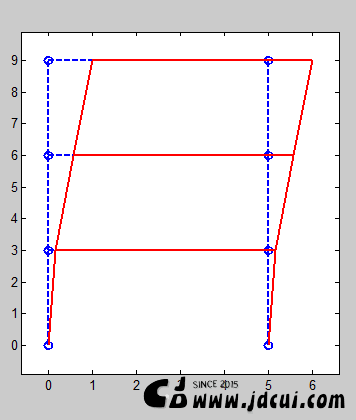
(a)第一阶
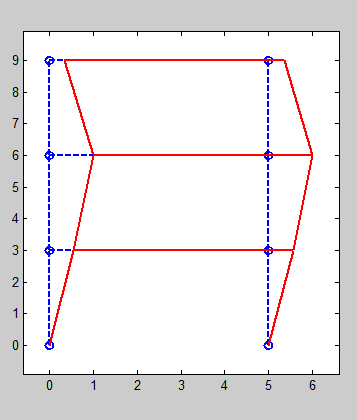
(b)第二阶
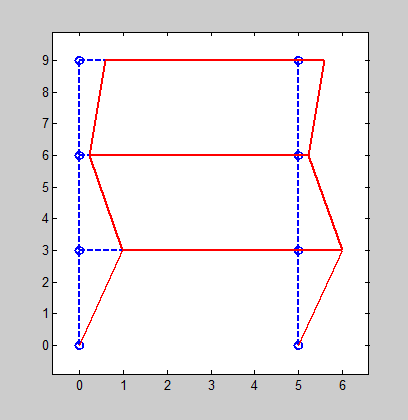
(c)第三阶
图 11‑8 框架结构屈曲模态
11.4.2 SAP2000分析结果对比
表 11‑2 给出了MATLAB分析的结构前6阶屈曲因子与SAP2000分析结果的对比,可以看出,两者吻合很好。
| 屈曲模态 | SAP2000结果 | MATLAB结果 | 相对偏差(%) |
|---|---|---|---|
| 1 | 74.696 | 74.696 | 0 |
| 2 | 154.931 | 154.931 | 0 |
| 3 | 302.256 | 302.256 | 0 |
| 4 | 520.888 | 520.888 | 0 |
| 5 | 786.546 | 786.546 | 0 |
| 6 | 997.026 | 997.026 | 0 |
表 11‑2 2D框架架屈曲分析结果对比
11.4.3 midas Gen分析结果对比
midas Gen模态分析过程与上节中桁架结构类似,此处不再赘述。midas Gen模态分析结果如图 11‑9所示,对比上述MATLAB分析结果与SAP2000分析结果,可见分析结果吻合很好。

图 11‑9 midas Gen屈曲分析结果
- 注释 ( Comments )
( 如果您发现有错误,欢迎批评指正。邮箱:jidong_cui@163.com . 如果您喜欢这篇博文,请在上面给我 点个赞 吧! 🙂 🙂
( If you found any mistakes in the post, please let me know. Email : jidong_cui@163.com. If you like this posts, please give me a “thumbs up“ rating on the above button! )
- 微信公众号 ( Wechat Subscription)
欢迎关注 “结构之旅” 微信公众号

